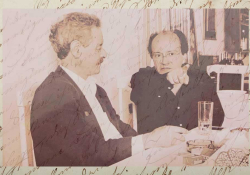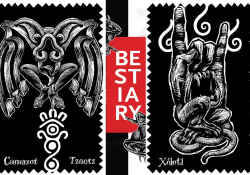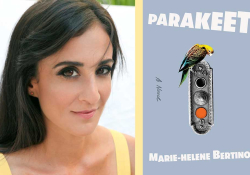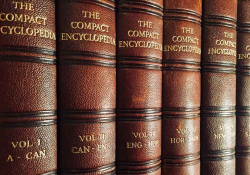White Asparagus: Remembering Tankred Dorst

Tankred Dorst (1925–2017) was one of the most performed German/European dramatists of the last century, and his plays are still being staged regularly. Stuart Friebert offers this remembrance.
1
Gifting me with one of his books I most cherish, Wie im Leben wie im Traum (Suhrkamp, 1990/As in Life As in a Dream), he inscribed it in something of a fragile hand: “Dear Stuart, I recall my time in Oberlin so fondly! When will we see each other again? I’m greeting, embracing you. Your old Tankred. Oct. 9, 2014.”
He managed to live three more years, but I never got to hug him again.
In 1970 we of the German Department at Oberlin (where I used to teach before founding, with help from colleagues, the Writing Program) were astonishingly unanimous about inviting Tankred to be the third Max Kade German Writer-in-Residence.[i] Peter Spycher and I’d begun teaching a bit of his work, especially the scary, wickedly mordant farce, Die Kurve (The curve), which engendered so much enthusiasm among students it convinced us to propose Tankred’s name. All I recall from the drive back from the airport, interrupted for some food and brews, was Tankred admonishing us not to get so “tanked” that Peter and I would miss a “curve” or two on the way back to Oberlin.
Besides teaching a seminar on his own work, Tankred was ever generous about visiting others’ classes as well as attending rehearsals of his play, Die Mohrin, which I’d decided to direct.[ii] He even wielded a hammer helping us build the set, notably a fanciful little boat he himself designed, which lived on as my kids’ adventure-craft, prominently moored in our backyard till the elements laid it waste. For some time, Tankred and I exchanged postcards: T: “Is it still ‘afloat’?” S: “Yep. Still shipshape.”
Thanks to Ellen Johnson, Oberlin’s preeminent art historian, who identified and championed emerging artists early on who would become more and more prominent, souls like Dine, Oldenburg, and Rauschenberg were invited to campus for extensive residencies. Learning of their presence, devotion, and gifts to Oberlin,[iii] Tankred was doubly delighted because he had followed and admired their work. Was it Tankred’s or my idea to project the image of Rauschenberg’s Bed on a wall, in which the play’s lovers, Aucassin and Nicolette, spend a night in a seedy hotel while fleeing their pursuers? In any event, Tankred and I shared a passion for stage business and spent perhaps more time doodling notions back and forth for how to keep the “images” flowing than attending to the rehearsals’ problems.[iv]
After Tankred returned to what he called “Little Europe,” having given a series of readings and talks at American universities once his Kade time was over at Oberlin, a group of students painted the “rock,” a large boulder in the square, as they’d sometimes do to praise or mourn a soul or an event: “Tankred is gone” is all it said or had to say. He wrote to say he was going to be sure to preserve the Polaroid we sent him of said rock.[v]
2
Some time later Tankred sent me the script of his film, Sand, which premiered on German TV in 1971. Directed by the preeminent Peter Palitzsch, it centers on the political assassin Karl Ludwig Sand, who stabbed August Friedrich Ferdinand von Kotzebue to death, a highly popular German dramatist who detested liberals and opposed free institutions. Sand, a theology student, was a militant member of the Burschenschaften, and Kotzebue’s murder gave Metternich the pretext to issue the Carlsbad Decrees, effectively disbanding the Burschenschaften, as well as targeting the liberal press, as well as egregiously restricting academic freedom in the states of the German Confederation. In short, the “subject” was ideally made for Dorst’s theatrical politics, aesthetics, and primal impulses, front and center in his strongest work.
The “subject” [political assassin Karl Ludwig Sand] was ideally made for Dorst’s theatrical politics, aesthetics, and primal impulses, front and center in his strongest work.
As soon as I read Sand, I wrote Tankred for permission to make a film of it with our students, with Peter Bichsel in a supporting role, who was at the time (1972) yet another Kade visiting writer. Peter was an admirer of Dorst’s work in general and his powerful drama Toller in particular, hence equally enthusiastic about the prospect.[vi]
Peter joined me to scout the landscape for possible scene-locations. Oberlin’s in the middle of fertile farmland, and we coursed many a side and back road to key on two primary “sets”: an old, out-of-the-way wall of some sort would serve a crucial scene; some sort of old schoolhouse as a setting for important deliberations. My old Taunus, a Ford import from its German counterpart that never took hold, was on its last legs, but I assured Peter if it gave out, a farmer would likely tractor-tow us back to town, as had in fact happened previously. Both Tankred and Peter had fun with its name, though having been a student in Germany, I actually knew more of the Taunus mountain range’s fauna and flora for having hiked there, and teased them back in spades.
Just west of town, we sighted what I remembered was a collapsing structure—many an older Oberlin building is of soft brick from a nearby quarry—that was in use as a corncrib and might offer up an ideal wall to stage the crucial scene. I was telling Peter the police blotter in the local rag occasionally reported kids playing there, who had to be chased away for fear one might suffocate under a sudden shift in the cob-mass, when a dog shot out of nowhere, barking so fiercely we thought it might hurtle through an open window. I swerved and must have caught it under a tire. By its shriek we suspected it was dead. Sure enough, and just as we parked to see about its slumped shape, a farmer wielding a pitchfork came running across the field shouting what turned out, to our relief, to be curses at his “damn dog.” He even apologized, as the “critter” had caused other cars to swerve dangerously! After adding our regrets for the dog’s demise, sensing the corncrib might belong to him, I asked his permission to explore it for the film. He grinned when I asked him to spell his name so I could thank him in the credits if the film came off.
After we tumbled around on the mountains of stored corn inside, lobbing cobs in each other’s direction like kids on the first day of summer vacation, Peter hooting to my hollering, I surprised, not to say scared, him a bit—after we dusted off—by brandishing two knives I’d been concealing. “Sand had armed himself with two knives in case one wouldn’t suffice,” I said, “when he tracked Kotzebue to his new abode in Mannheim, soon after he’d settled his family there.” Peter ran his finger down the blade of the one I gave him and drew blood, which he promptly licked up. An actor himself to the core, he dangled his hand as if severely wounded but recovered nicely to join me stabbing in myriad ways at the crumbling brick wall. I wanted to be sure it would hold up when David Walker, playing Sand, practiced murdering Kotzebue in rehearsals. Incidentally, the wall suffered David going at it over and over again quite well, first with one knife, then the other.[vii]
3
Because Peter had to go off for a spell giving readings elsewhere, I took Paul Buck along to scout for any structure that might suffice as a schoolhouse. A student in German as well as an art major, Paul was also a skilled photographer and readily agreed to film the script with equipment on loan from the Art Department. Several days into circling the surrounding landscape, often stopping to boot up to explore under- and backwoods, we finally came across an old red brick schoolhouse collapsing in on itself, sitting back a hundred yards or so from the road. Paul lugged his tripod and cameras along to take a number of shots we could use to draft the scene’s action—the Burschenschaften gang Sand had managed to conscript to plot a course of action that would result in catching Kotzebue at an unguarded moment to dispatch.
With a decent storyboard to work from, rehearsing away in a classroom at the college, we finally caravanned out on a weekend, prepared to camp overnight at the site to build “believability” into the scene, exposing bodies and temperaments to the night’s effects. So-called best laid plans were alarmingly interrupted not long after we set up camp among the ruins and reconnoitered to identify hazards: rusty nails sticking out; glass shards hidden by grass; jagged wood sticking out of dark places. A familiar siren pierced our ears, and soon after, breaking through the underbrush, a nattily clad state trooper strode toward me, likely taking me to be in charge of our motley group. The farmer who owned the land must have spotted Paul and me earlier, so when we returned he called the cops.
The trooper came straight to the point: “You are trespassing, Sir!” Perhaps he said it more politely than I heard it, but, rattled, I made the mistake of sputtering something in German, which we’d been speaking among ourselves to keep the script alive. “Excuse me?” he said more pointedly, and took a step closer. At that point, the students clotted together, looking worried as well. Recovering my senses, I blurted out, “Oops, guess we should have asked someone’s permission to be out here . . .” “You’ve got that right, Sir.” Babbling on about why we were there, I must have satisfied the trooper enough because he began to smile when it was apparent we were up to a harmless pursuit. “The owner would appreciate your heading over to his house asap,” he softened his voice. Pointing behind us to a house we could barely make out through the foliage, he saluted smartly, touched the brim of his hat, even advised us to be careful “what with the debris out here,” and left. Days later, the gang was still exchanging snappy salutes among themselves. As with the owner of the corncrib, the fellow who owned the film site was happy to have his name listed in the credits. When Peter and Tankred got the full report I filed with them, as well as with the chairman of the German Department to cover my “professional” tracks, they went on teasing me mercilessly again. After showing the film to German classes, I had a copy made for Tankred and Peter but have since looked in vain for the original in the German Department’s nooks and crannies: LOST, still . . .
4
When I wrote Tankred I’d be passing through Munich while touring my last book of German poems, he offered me a bed for a few days if I had time to “visit and renew our friendship.”[viii] White asparagus, he’d written, would be right in season, so be prepared to eat them around the clock, he joked, or so I thought at first![ix] However, there they were on lunch and dinner plates for several days, albeit dressed up variously, and always prepared to perfection by both Tankred and Ursula (Ehler), by then his wife, and since the 1970s his co-collaborator in spades, hearts, clubs, and diamonds. Indeed, I know of no other writer, major or minor, who has left us so many works—some thirty plays, at least eight story collections and novels, four major films, and several translations—co-written with anyone, not to mention with a mate.[x] It was clear from being around them even for a bit that their hearts fairly seemed to beat as one, hang the clichéd sentiments of many a sappy song; and if I’d not lost the journal I kept on that trip, I could cite exchanges between them as if spoken by one mind, which I couldn’t help but record for their aperçus and wit.
Having to post a letter the day I left—Ursula and Tankred were driving me to the airport—what I still recall as vividly as if it happened yesterday is what happened while we were waiting in line at the P.O.’s window. By way of already beginning to say goodbye, I finally landed on one of my family’s fondest memories, of Tankred’s coming to our house in Oberlin for supper. I reminded him that as soon as we’d introduced him to our kids, then five and seven, he tenderly lifted them up by the hands to the top of his shoes and began skating them about, which we then kept doing in his memory till they got too big for us.
As soon as we’d introduced him to our kids, then five and seven, Tankred tenderly lifted them up by the hands to the top of his shoes and began skating them about, which we then kept doing in his memory till they got too big for us.
While I babbled on, I could see Ursula’s and Tankred’s gazes drifting. I’d been somewhat aware a couple in line ahead of us were having something of a heated argument, but it turns out Ursula and Tankred were virtually recording every word the couple exchanged. Waiting till we were back in the car, they let loose, reenacting the scene out to the syllable! Tankred: “Did you hear her say to him?!”; Ursula: “And did you hear her rejoinder?!” They laughed their sweet together-laugh when I said, “Okay, dearies. I’ll look for the whole back-and-forth in your next play!”
Now that Tankred’s gone and died—when Günter Eich died, Peter Bichsel lamented, “He could have gone ahead and died if he’d only stuck around longer—I pray that Ursula, wherever she is now, is in a good patch, and for sure she must know what bountiful, great gifts they’ve left to the rest of us.
Oberlin, Ohio
[i] For a biographical overview of Tankred Dorst’s life and letters as well as a note from him about his stay at Oberlin, see Willkommen und Abschied: Thirty-five Years of German Writers-in-Residence at Oberlin College, edited by Dorothea Kaufman and Heide Thomann Tewarson (Camden House, 2005).
[ii] Of all the courses I’ve had the opportunity to propose, “German Studio Theater” tops the list. In the first half, students would study scripts, which we’d spend the second half staging, either in Oberlin’s Hall Auditorium (named for Charles Martin Hall: Google the “story” of aluminum!), or in the Little Theater. Other plays we staged included Gryphius’s Leo Armenius (with an original musical score by Ben Bagby, then a student in the course, who has since become world-famous performing Beowulf, memorized as written, for which Ben’s crafted an instrument likely used at the time); Goethe’s Egmont; Kleist’s Der zerbrochene Krug; Büchner’s Leonce und Lena and Wozzeck; Kaiser’s Von Morgens bis Mitternacht; Brecht’s Die Eisenhandlung; Frisch’s Biedermann und die Brandstifter; and Hochwälder’s Der Himbeerpflücker (Fritz Hochwälder immediately preceded Dorst as a Kade writer).
[iii] Oldenburg’s Giant Three-Way Plug was installed in 1970 during Dorst’s residency, and I wish I had a picture of Tankred climbing all over it when he learned it wasn’t “forbidden”!
[iv] Tankred especially loved hearing of Hume Croyn’s “business” in The Miser at the Guthrie Theater in Minneapolis in 1963: when “The Miser” sneezed, he skirted around the stage chasing bits of snuff his nose had ejected. I loved hearing of Tankred’s idea of having Friedrich Engels’s father, who owned a textile factory in England in which young Engels worked for a time, yank great bolts of cloth off the walls in a cavernous hall and slowly wind them around his son till he mummified him. Alas, so far as I know, Tankred never finished the play I believe he intended to call “Engels.”
[v] “The End of Playwriting,” the talk he wrote in Oberlin to deliver on his tour, went over wonderfully when he tried it out on us before leaving on his final tour. As he’s written, he played with the notion that future theater could do without playwrights. Perhaps someone knows where there might be a print copy?
[vi] Both Tankred and Peter were amused to learn I’d once tried to entice Peter Lorre to play the lead in Brecht’s early one-act, Die Eisenhandlung, joined by our student actors. Alas, Lorre died in the midst of negotiations to bring him to campus.
[vii] I’d already cast most roles, especially Sand’s and his most trusted friend’s. Imagine having not only David Walker in your class, one of our most gifted, downright brilliant students ever, who’s since become one of Oberlin’s most beloved professors (and incidentally also teaches at times in the Writing Program, co-edits Field/OC Press as well) but also Franz Wright (RIP)—who with James Wright, his father, are the only father-son poets to win the Pulitzer Prize—whom I cast as Sand’s best friend. John Mahnke (RIP)—perhaps the most promising poet-in-spe of the lot—played another member of Sand’s inner circle. While Bruce Weigl, another of the amazing young poets taking the class and currently one of America’s most prominent authors, didn’t try out for a part, he offered valuable suggestions all along.
[viii] Nicht Hinauslehnen had just been published by Delp Verlag (1975) in Bad Windsheim, close by Munich where Dorst and his mate, Ursula Ehler, had settled down.
[ix] The only other time I’d had the great pleasure of eating more white asparagus than I should have, my former professor at the University of Wisconsin, Werner Vordtriede, had invited me to a lunch of white asparagus alone, accompanied by the most expensive wine I’d ever drunk (white of course!). We met in a posh Munich restaurant some years earlier to celebrate our appearing back-to-back in Neue deutsche Hefte; I with the first publication of my German poems, and Vordtriede with his marvelous essay on Der junge T. S. Eliot, which I was privileged to be allowed to translate recently by his estate, and appeared in the online European journal Voyages. While I had the distinct impression Vordtriede was quite surprised I was writing poems in German—I’d’ not been one of his best students—all he said about my texts was that some might think it impertinent to mention Celan, as I did, in a poem at all: enough said!
[x] On a few occasions, I’ve actually overheard some writers confess, knowing of Tankred’s and Ursula’s “model,” that they might have done more than footnote another souls’ contributions, not to mention a mate’s . . .











